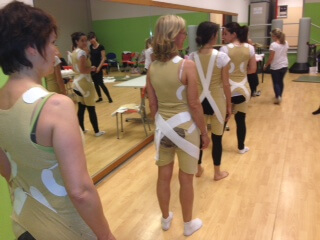Certified TheraTogs Fitter (CTF) Level I
 Course Summary
Course Summary
This introductory program features a review of relevant pediatric orthopedic issues and sciences pursuant to neuromotor re-education for posture and torso alignment, including:
-
Skeletal modeling mechanisms and influences
-
The role of the somatosensory system in postural control acquisition and movement
-
Fundamentals of S.A. Sahrmann’s muscle balance theory
-
Practice-related skills acquisition
Attendees will validate their understanding of these principles and issues in the afternoon lab session, using the TheraTogs Posture & Torso Alignment system. Grouped in teams of three, attendees will be guided through a series of donning and strapping applications that demonstrate the biomechanical principles and management techniques reviewed in the morning session.
Attendees are under no obligation to use the TheraTogs or Dragonfly orthotic systems in the care and treatment of clients. Attendees who successfully complete the on-site practicum exam with a passing score (50 out of 58) on the lab skills in order to receive a Certified TheraTogs Fitter (CTF) Level I credential, and may then attend the Level II workshop.
Course Objectives
By the end of the workshop, the participant will be able to:
-
Compare the location of the body center of mass (COM) in an infant compared with an adult.
-
Explain the primary benefit of antigravity righting reactions to body COM (weight) shifts in daily function.
-
Explain the three sequential, plane-based phases of acquisition of antigravity muscle function and control in the neck and torso.
-
Relate postural alignment to somatosensory input from loaded joints and segments.
-
Compare the status of sensory processing in typically developing children to that of children with hypotonia and cerebral palsy.
-
Define the relationship between postural control and acquisition and functional limb use.
-
Explain 2 ways that postural alignment influences muscle recruitment strategies needed for upright maintenance and limb use.
-
Explain the physiologic effect of massed practice of balance and movement skills on the developing brain.
-
Differentiate between muscle dominance and muscle strength.
-
Explain Sahrmann’s focus on shortening the dominant muscles and using them in their shortened state before attempting to lengthen the shortened, dominant muscles.
By the end of the lab session, the participant will correctly apply the TheraTogs garment system for client diagnosed with:
-
Flexible thoracic kyphosis
-
Flexible thoracolumbar kyphosis
-
Flexible lumbar lordosis
-
Excessive pelvic ante version
-
Diminished pelvic anteversion
-
Anterior body weight displacement over the feet.
